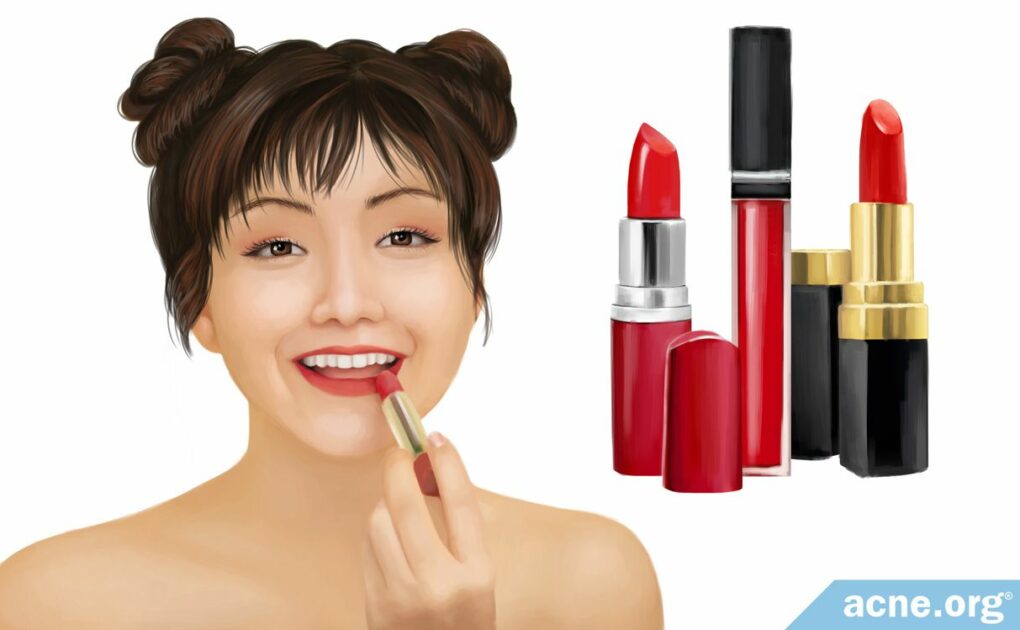Choose Lip Products That Do Not Contain Any Pore-clogging Ingredients

The Essential Info
If you are acne-prone, the best strategy for choosing lip makeup is to look at the ingredients. Avoid any products that contain pore-clogging ingredients.
Also avoid fragranced products, which may irritate the skin in some people or cause allergies.
Important Considerations When Using Lip Makeup
- Apply it only on lips: Be careful not to apply it on the skin around the lips, which is more prone to breakouts.
- Remove it gently: Physical irritation of the skin can lead to more acne. Remove lip makeup using a featherlight touch.
- Don’t use expired makeup: Some oils in lip makeup can go rancid. Use only fresh makeup.

The Science
- Guidelines for Choosing Lip Makeup for Acne-prone Skin
- List of Common Pore-Clogging (Comedogenic) Ingredients in Makeup
- Tips for Using Lip Makeup on Acne-prone Skin
- Lip Makeup Ingredients: The Details
With the enormous range of lip cosmetics available on the market, choosing a good lipstick, lip liner, or lip gloss for acne-prone skin can feel like a daunting experience.
- Lipstick: A soft solid that colors the lips, defines lip shape, and may provide some protection from the sun, wind, and/or dry weather
- Lip liner: A solid that defines the outer border of the lips and prevents migration of lipstick and lip gloss from the lips
- Lip gloss: A liquid that adds shine and sometimes color to the lips, and may provide some protection from the sun, wind, and/or dry weather
While acne does not develop on the lips, lip makeup can easily migrate to the skin around the mouth, where it might potentially trigger acne.1 Therefore, it is important to select lip cosmetics that are safe for acne-prone skin.
The good news is that choosing a suitable lip product for acne-prone skin is not as difficult as it seems.
Guidelines for Choosing Lip Makeup for Acne-prone Skin
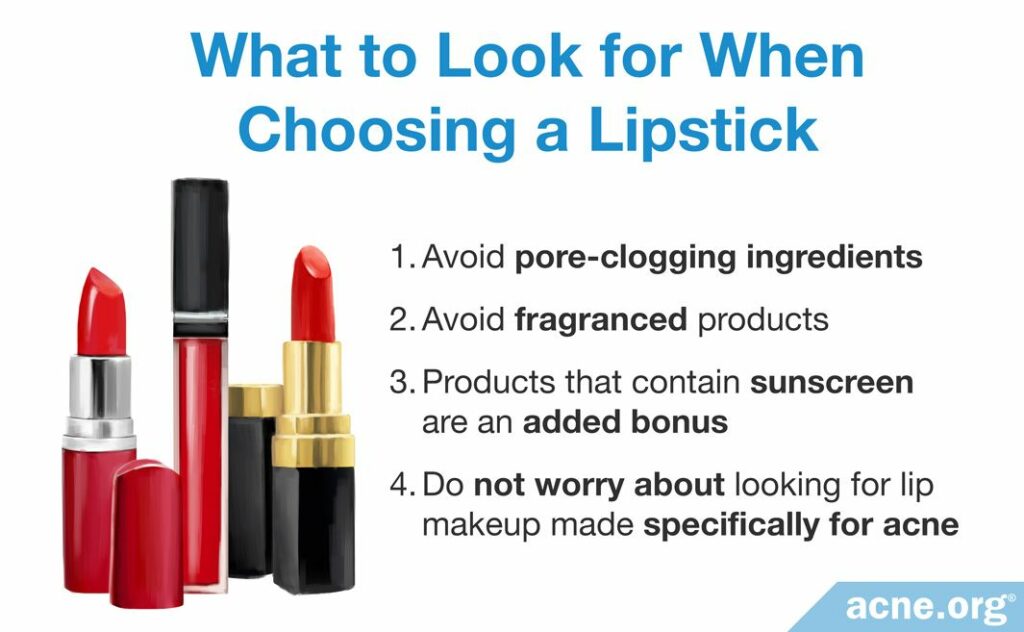
- Avoid pore-clogging ingredients: Before buying a makeup product, always check the list of ingredients. Avoid lip makeup that contains pore-clogging (comedogenic) ingredients. The table below provides a complete list of common comedogenic ingredients.
- Avoid fragranced products: Some lip makeup contains added fragrances. Some fragrances can trigger allergies and may irritate some people’s skin. We know that irritation can aggravate acne, so the best strategy is to choose unscented lip makeup.
- Products that contain sunscreen are an added bonus: The skin on the lips can burn in the sun, just like skin on other parts of the body. If your lip makeup is labeled with an SPF (sun protection factor), that is welcome.
- Do not worry about looking for lip makeup made specifically for acne: You may have heard advice to look for makeup that contains salicylic acid, which is a common active ingredient in over-the-counter anti-acne products. While salicylic acid is somewhat beneficial for acne-prone skin, the vast majority of lip makeup does not contain this ingredient, so do not worry about trying to find a lip stick or lip gloss with salicylic acid.
List of Common Pore-Clogging (Comedogenic) Ingredients in Makeup
Many scientific studies have looked at various ingredients in skincare and makeup products, zeroing in on how likely these ingredients are to cause clogged pores (comedones).2 Based on a thorough review of this research, we have compiled two lists:
- Definitely avoid: These are ingredients that people with acne-prone skin should definitely avoid, because a compelling amount of evidence shows that they are comedogenic.
- Consider avoiding: These are ingredients that people with acne-prone skin may want to consider avoiding, because a less compelling amount of evidence suggests that they might be comedogenic.
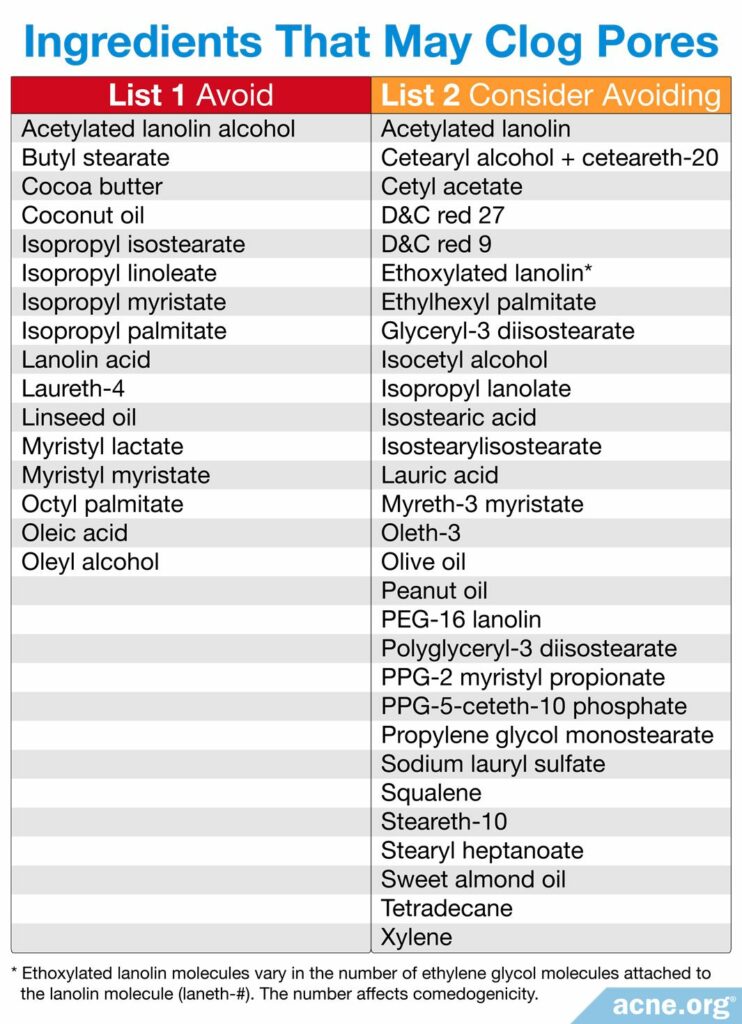
Tips for Using Lip Makeup on Acne-prone Skin
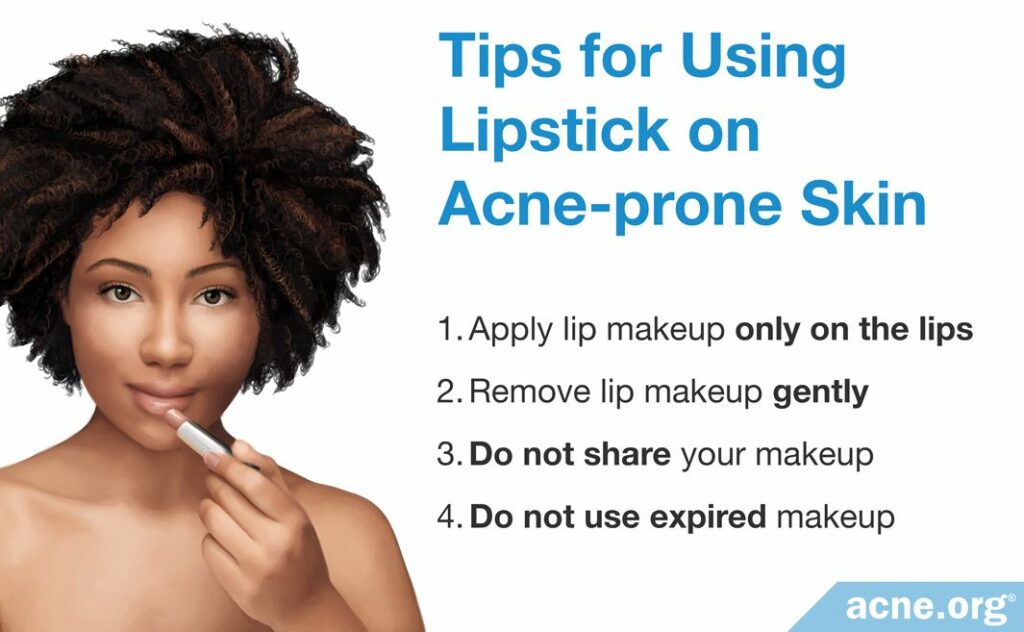
Physical irritation of the skin can make acne worse. Therefore, it is important to avoid irritating the skin when applying lip products. It is also important to practice good hygiene. When it comes to using lip makeup on acne-prone skin, keep these tips in mind:
- Apply lip makeup only on the lips: Lip makeup that comes in contact with perioral skin (skin around the mouth) might potentially trigger acne in this area. To prevent this, carefully apply lip makeup only on the lips, and avoid applying it beyond the lip line. This is especially important when applying lip liner, which is meant to be applied to the edges of the lip.
- Remove lip makeup gently: To avoid physically irritating the skin around the mouth, stay very gentle when removing lip makeup. You can easily remove lip cosmetics using cotton pads wetted with jojoba oil and/or makeup removers. Use gentle motions to avoid irritating perioral skin.
- Do not share your makeup: Sharing personal makeup increases your chances of getting a skin infection.
- Do not use expired makeup: Lip makeup that is past its expiration date can start to go rancid or begin to harbor bacteria. Never use lip cosmetics that have expired.
Now we’ll dig deeper and have a look at the various ingredients in lip makeup products.
Lip Makeup Ingredients: The Details
Lipstick, lip gloss, and lip liner are essentially different combinations of the same three types of ingredients:
- Waxes: To make the makeup product solid and robust
- Oils*: To make the makeup product soft or fluid and to moisturize the lips
- Pigments*: To add color to the makeup product1
*Some oils and pigments are comedogenic. Before purchasing any lipstick, lip liner, or lip gloss, check its ingredients, and do not buy the product if it contains any comedogenic ingredients from the table above.
Lipstick, lip liner, and lip gloss and all contain each of these three components, but in different relative amounts. These amounts depend on the purpose of each lip product and its desired hardness and texture:
- Lipstick:
- Purpose: Lipstick colors the lips, defines lip shape, and provides some protection from the sun and/or dry, cold, and windy weather.
- Hardness: Lipstick is normally solid, but soft. It usually comes in a tubular plastic container.1
- Lip liner:
- Purpose: Lip liner primarily defines the outer border of lips and prevents the migration of lipstick or lip gloss from the lips.
- Hardness: Lip liner is solid and comes in the form of a pencil or in a thin swivel container.1
- Lip gloss:
- Purpose: Lip gloss primarily makes the lips look shiny, but also adds some color and definition to the lips and may provide protection from the sun and/or wind.
- Hardness: Lip gloss is normally liquid. It usually comes in a pot or container with an applicator wand.1
Because of these differences in purpose and desired hardness, lipstick, lip liner, and lip gloss contain different relative amounts of waxes, oils, and pigments:
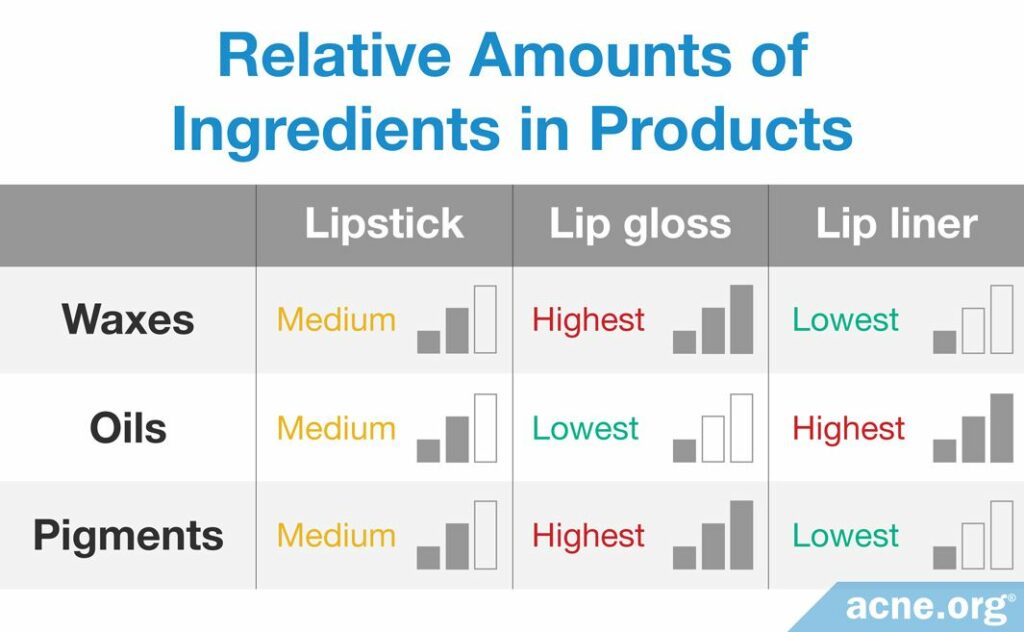
The bottom line is that all three types of lip makeup products can potentially contain comedogenic oils and/or pigments. This is why the best strategy for choosing a lipstick, lip liner, or lip gloss is to check the list of ingredients and avoid any product that contains comedogenic ingredients found in the table at the top of this article.
Lip makeup ingredients: The full scoop
Waxes
Waxes are non-comedogenic, which means they are safe for acne-prone skin.
Waxes are the #1 ingredient in lipsticks and lip liners, while lip glosses contain little or no wax. The purpose of waxes in lip products is to provide solidity and prevent crumbling, so that the product can maintain stick form.
Like all ingredients in lip makeup, the waxes used for making lipstick and lip liner must also be safe to ingest. Manufacturers normally have to use several different waxes to make a lip product with the desired texture and consistency.1
There are three main types of waxes in lipsticks and lip liners:
1. Mineral waxes: These waxes come from coal, shale, or petroleum and include ozocerite, paraffin, ceresin, and microcrystalline petroleum. Mineral waxes are relatively inexpensive and are good for providing solidity, but their texture does not match the lipids (waxes and oils) naturally found on the skin.
2. Vegetable waxes: These waxes come from plants and include sugarcane wax, carnauba wax, and candelilla wax. Because these waxes come from living things, their texture is closer to the lipids naturally found on the skin.
3. Animal waxes: These waxes come from animals and include beeswax, spermaceti, and lanolin. Because these waxes come from living things, their texture is closer to the lipids naturally found on the skin.3
The amount of wax in any given lipstick or lip liner can vary from 5% to 90%.3
Oils
Since some oils in lip cosmetics are comedogenic, it is important to check the ingredients of your lip products and make sure none of them appear in the list of comedogenic ingredients at the beginning of this article.
Oils in lipsticks and lip glosses make these products softer and moisturize the lips. The more oil a lip product contains, the shinier it makes the lips look, so lip gloss contains a particularly large amount of oil. Oil also makes it easier to spread pigment on the lips. Lip liner, which is quite hard and not glossy, contains the least oil of the three types of lip products.
There are two main types of oils in lip makeup products3:
1. Volatile oils: These types of oils evaporate easily. They include:
a. Silicone-based oils: These are non-comedogenic and include octamethylcyclotetrasiloxane, decamethylcyclopentasiloxane, and hexamethyldisiloxane.
b. Volatile hydrocarbons: These are also non-comedogenic and include pentane, hexane, decane, and dodecane.
2. Non-volatile oils: These types of oils do not evaporate. They include:
a. Synthetic oils: These oils are made in a laboratory, and some of them are comedogenic. Synthetic oils in lip cosmetics include isostearyl neopentanoate, cetyl myristate, and decyl isostearate.
b. Vegetable oils: These oils come from vegetable sources, and some of them are comedogenic. Vegetable oils in lip cosmetics include castor oil, lanolin oil, coconut oil, and olive oil.
Pigments
Some pigments are comedogenic.
Pigments lend color to the lips and are thus the third most important ingredient in lipsticks, lip liners, and lip glosses.
There are three major types of pigments in lip makeup:
1. Organic pigments: These pigments consist of chemicals that contain carbon. In the United States, organic colors that are approved for use in makeup are divided into two groups:
a. FD&C pigments: This is a designation for food, drug and cosmetics, so these pigments are very safe.
b. D&C pigments: This is a designation only for drugs and cosmetics, but these pigments are still safe to ingest.
2. Inorganic or mineral pigments: These pigments consist of chemicals that do not contain carbon.
3. Lakes: Lakes are a combination of organic pigments and inorganic materials like aluminum hydroxide.1
Additional ingredients in lip makeup
Some flavorants and fragrances can be irritating to the skin. Since irritation can aggravate acne, this can sometimes be a concern.
In addition to the three main ingredients, lip makeup may also contain:
- Vitamins and antioxidants: To promote lip health, manufacturers may add vitamins and antioxidants such as tocopherol acetate and green tea extract.
- Sunscreens: To protect the lips from burning in the sun, manufacturers may add sunscreen ingredients such as titanium dioxide or octinoxate.
- Flavorants: To add a pleasant flavor, particularly in the case of lip glosses, manufacturers may include natural flavors.
- Fragrances: To add a pleasant smell, manufacturers may add various fragrances. As these may cause skin irritation or allergies in some people, opt for scent-free products if possible.1
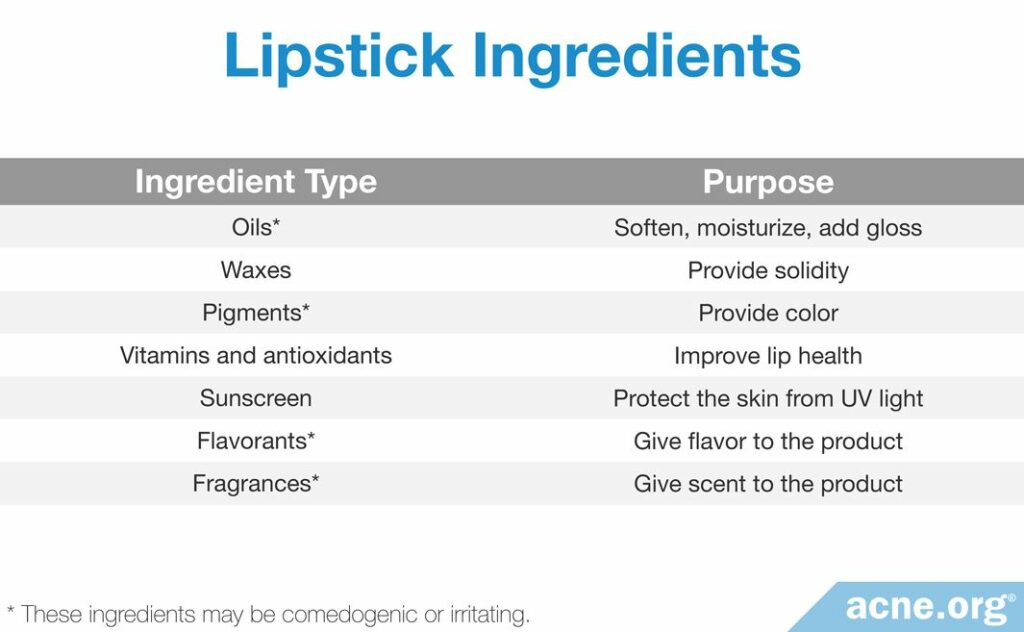
References
- Engasser, P. G., Lip Cosmetics, Dermatologic Clinics, 18(4), 641-649, (2000). https://www.sciencedirect.com/journal/dermatologic-clinics/vol/18/issue/4
- Katoulis A. C., Kakepis E. M., Kintziou H., Kakepis M. E. & Stavrianeas N. G., Comedogenicity of cosmetics: a review, Journal of the European Academy of Dermatology and Venereology, 7, 115-119 (1996). https://onlinelibrary.wiley.com/doi/abs/10.1111/j.1468-3083.1996.tb00606.x
- El-Nokaly, M., Walling, D. W., Vatter, M. L. & Leatherbury, N. C. Lipsticks compositions containing association structures, United States Patent, No 6,325,995. Date: December 4, 2001. https://patents.google.com/patent/US6325995B1/en
 Acne.org Products
Acne.org Products